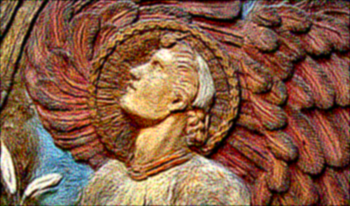References
1LauD. L.ArceG. R.Modern Digital Halftoning2018CRC PressBoca Raton, FL
2UlichneyR.Digital Halftoning1987MIT PressCambridge, MA
3FloydR. W.SteinbergL.1976An adaptive algorithm for spatial gray-scaleProc. Soc. Inf. Disp17757775–7
4OstromoukhovV.2001A simple and efficient error-diffusion algorithmProc. 28th Annual Conf. on Computer Graphics and Interactive Techniques567572567–72ACMNew York City, NY10.1145/383259.383326
5ZhouB.FangX.2003Improving mid-tone quality of variable-coefficient error diffusion using threshold modulationACM Trans. Graph.22437444437–4410.1145/882262.882289
6JarvisJ. F.JudiceC. N.NinkeW. H.1976A survey of techniques for the display of continuous tone pictures on bilevel displaysComput. Graph. Image Process.5134013–4010.1016/S0146-664X(7680003-2
7StuckiP.1981MECCA-a multiple-error correction computation algorithm for bi-level image hardcopy reproduction, IBM Thomas JWatson Research DivisionIBM Thomas J. Watson Research CenterNew York City, NY
8AnalouiM.AllebachJ. P.1992Model-based halftoning using direct binary searchHuman Vision, Visual Processing, and Digital Display III16669610896–10810.1117/12.135959
9GooranS.2004Dependent color halftoning: Better quality with less inkJ. Imaging Sci. Technol.48354362354–62
10LiebermanD. J.AllebachJ. P.1997Efficient model based halftoning using direct binary searchProc. Int’l. Conf. on Image Processingvol. 1775778775–8IEEEPiscataway, NJ10.1109/ICIP.1997.648077
11LiebermanD. J.AllebachJ. P.2000A dual interpretation for direct binary search and its implications for tone reproduction and texture qualityIEEE Trans. Image Process.9195019631950–6310.1109/83.877215
12LiH.MouldD.2010Contrast-aware halftoningComput. Graph. Forum29273280273–8010.1111/j.1467-8659.2009.01596.x
13EschbachR.KnoxK. T.1991Error-diffusion algorithm with edge enhancementJOSA A8184418501844–5010.1364/JOSAA.8.001844
14PangW. M.QuY.WongT. T.Cohen-OrD.HengP.-A.2008Structure-aware halftoningACM SIGGRAPH 2008 Papers181–8ACMNew York City, NY10.1145/1360612.1360688
15ChangJ.AlainB.OstromoukhovV.2009Structure-Aware Error DiffusionTOG28181–810.1145/1618452.1618508
16LiuL.ChenW.ZhengW.GengW.2014Structure-aware error-diffusion approach using entropy-constrained threshold modulationVis. Comput.30114511561145–5610.1007/s00371-013-0895-0
17KwakN. J.RyuS. P.AhnJ. H.Edge-enhanced error diffusion halftoning using human visual propertiesProc. Int’l. Conf. on Hybrid Information Technology2006Vol. 1IEEEPiscataway, NJ499504499–50410.1109/ICHIT.2006.253533
18LiX.2006Edge-directed error diffusion halftoningIEEE Signal Process. Lett.13688690688–9010.1109/LSP.2006.879465
19LeeH. S.KongK. K.HongK. S.“Laplacian based structure-aware error diffusionInt’l. Conf. on Image Processing2010IEEEPiscataway, NJ525528525–810.1109/ICIP.2010.5651243
20LiD.KiyotomoT.HoriuchiT.TanakaM.ShigetaK.2020Texture-aware error diffusion algorithm for multi-level digital halftoningJ. Imaging Sci. Technol.64504105041150410–110.2352/J.ImagingSci.Technol.2020.64.5.050410
21AbediniF.GooranS.KitanovskiV.NyströmD.2021Structure-aware halftoning using the iterative method controlling the dot placementJ. Imaging Sci. Technol.6560404-110.2352/J.ImagingSci.Technol.2021.65.6.060404
22HoughP. V.
23GooranS.KruseB.2015High-speed first- and second-order frequency modulated halftoningJ. Electron. Imag.241191–1910.1117/1.JEI.24.2.023016
24GooranS.AbediniF.20203D surface structures and 3D halftoningProc. IS&T Printing for Fabrication 2020697469–74IS&TSpringfield, VA
25CampbellF. W.RobsonJ. G.1968Application of Fourier analysis to the visibility of gratingsThe J. Phys.197551
26JainA. K.FarrokhniaF.1991Unsupervised texture segmentation using Gabor filtersPattern Recognit.24116711861167–8610.1016/0031-3203(91)90143-S
27SharmaG.BalaR.Digital Color Imaging Handbook2017CRC PressBoca Raton, FL
28ShakedD.AradN.FitzhughA. E.SobelI. E.1998Color diffusion: error diffusion for color halftonesProc. SPIE364810.1117/12.334589
29
30PappasT. N.NeuhoffD. L.1999Least-squares model-based halftoningIEEE Trans. Image Process.8110211161102–1610.1109/83.777090
31NäsänenR.1984Visibility of halftone dot texturesIEEE Trans. Syst. Man Cybern.SMC-14920924920–410.1109/TSMC.1984.6313320
32DalyS. J.RabbaniM.ChenC. T.
33ZhangX.WandellB. A.1997A spatial extension of CIELAB for digital color image reproductionJ. Soc. Inf. Disp.5616361–310.1889/1.1985127
34CreteF.DolmiereT.LadretP.NicolasM.2007The blur effect: perception and estimation with a new no-reference perceptual blur metricProc. SPIE649264920110.1117/12.702790
35WangZ.BovikA. C.SheikhH. R.SimoncelliE. P.2004Image quality assessment: from error visibility to structural similarityIEEE Trans. Image Process.13600612600–1210.1109/TIP.2003.819861
36
37HarenH.
38
39AbediniF.Trujillo VazquezA.GooranS.KleinS.2023Effect of halftones on printing iridescent colorsAccepted for Presentation at the Color Imaging: Displaying, Processing, Hardcopy, and Applications Conf., at IS&T Electronic ImagingIS&TSpringfield, VA
40AbediniF.GooranS.NyströmD.20203D halftoning based on iterative method controlling dot placementProc. IS&T Printing for Fabrication697469–74IS&TSpringfield, VA
41AbediniF.GooranS.NyströmD.2021The effect of halftoning on the appearance of 3D printed surfaces47th Annual Conf. of IarigaiIarigaiDarmstadt, Germany

 Find this author on Google Scholar
Find this author on Google Scholar Find this author on PubMed
Find this author on PubMed